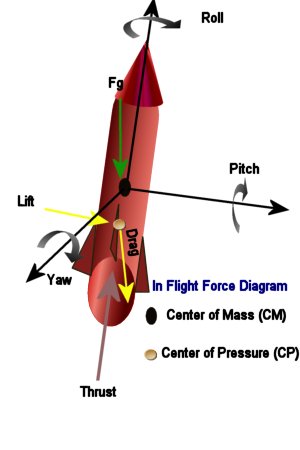Free Body Diagram

The 4 main forces acting on a rocket are the, Force of Gravity, Drag, Lift, and Thrust. The force of gravity, and the thrust act through the center of mass. Lift and drag acts at the center of pressure of the rocket.
The center of pressure varies depending on the distribution of drag and lift across the rocket. Some factors that affect this distribution are, nose design, fin size/shape, and a material's "smoothness".
External force such as a gust of wind will cause a torque about the center of mass. The torques cause rotation around the rockets axes. This rotation is referred to as Roll, Pitch, and Yaw. Roll isn't a problem, because it doesn't affect the rockets path. Even small amounts of pitch or yaw could create serious problems.
Conventional rockets stabilize themselves using fins in the rear. They work exactly like a weather vane. Here the center of mass is at the point where the arrow rotates about support. When the wind blows it causes a torque at the center of mass which forces the tip to point upwind.

http://www.weathervanes.co.uk/images/Weathervanepics/Miscellaneous/chevron.jpg
The beauty with this system is that it is "passive". This means if a rocket rotates, drag will act at the center of pressure in the opposite direction of the velocity, and it will "right" itself. This is known as a restoring force. (see the diagram above)
Unfortunately in space there is little atmosphere and thus no drag to act as a restoring force. This is why you don't see fins on shuttles. To maintain stability, shuttles use an adjustable nozzle to deflect thrust one way or another. When in orbit, they use thrusters known as vernier rockets. These are actually small rockets placed on various parts of the ships exterior.
